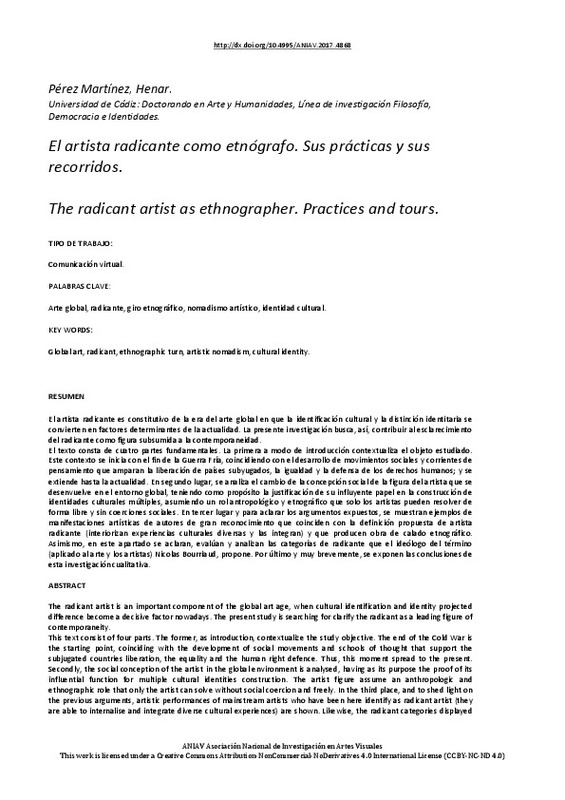JavaScript is disabled for your browser. Some features of this site may not work without it.
Buscar en RiuNet
Listar
Mi cuenta
Estadísticas
Ayuda RiuNet
Admin. UPV
El artista radicante como etnógrafo. Sus prácticas y sus recorridos
Mostrar el registro sencillo del ítem
Ficheros en el ítem
| dc.contributor.author | Pérez Martínez, Henar
|
es_ES |
| dc.date.accessioned | 2018-09-06T06:22:32Z | |
| dc.date.available | 2018-09-06T06:22:32Z | |
| dc.date.issued | 2017-10-23 | |
| dc.identifier.isbn | 9788490485736 | |
| dc.identifier.uri | http://hdl.handle.net/10251/106663 | |
| dc.description.abstract | [EN] The radicant artist is an important component of the global art age, when cultural identification and identity projected difference become a decisive factor nowadays. The present study is searching for clarify the radicant as a leading figure of contemporaneity. This text consist of four parts. The former, as introduction, contextualize the study objective. The end of the Cold War is the starting point, coinciding with the development of social movements and schools of thought that support the subjugated countries liberation, the equality and the human right defence. Thus, this moment spread to the present. Secondly, the social conception of the artist in the global environment is analysed, having as its purpose the proof of its influential function for multiple cultural identities construction. The artist figure assume an anthropologic and ethnographic role that only the artist can solve without social coercion and freely. In the third place, and to shed light on the previous arguments, artistic performances of mainstream artists who have been here identify as radicant artist (they are able to internalise and integrate diverse cultural experiences) are shown. Likewise, the radicant categories displayed by the term ideologist, Nicolas Bourriaud, are evaluated, analysed and cleared up. Finally and briefly, the conclusions of this qualitative research are presented. | es_ES |
| dc.description.abstract | [ES] El artista radicante es constitutivo de la era del arte global en que la identificación cultural y la distinción identitaria se convierten en factores determinantes de la actualidad. La presente investigación busca, así, contribuir al esclarecimiento del radicante como figura subsumida a la contemporaneidad. El texto consta de cuatro partes fundamentales. La primera a modo de introducción contextualiza el objeto estudiado. Este contexto se inicia con el fin de la Guerra Fría, coincidiendo con el desarrollo de movimientos sociales y corrientes de pensamiento que amparan la liberación de países subyugados, la igualdad y la defensa de los derechos humanos; y se extiende hasta la actualidad. En segundo lugar, se analiza el cambio de la concepción social de la figura del artista que se desenvuelve en el entorno global, teniendo como propósito la justificación de su influyente papel en la construcción de identidades culturales múltiples, asumiendo un rol antropológico y etnográfico que solo los artistas pueden resolver de forma libre y sin coerciones sociales. En tercer lugar y para aclarar los argumentos expuestos, se muestran ejemplos de manifestaciones artísticas de autores de gran reconocimiento que coinciden con la definición propuesta de artista radicante (interiorizan experiencias culturales diversas y las integran) y que producen obra de calado etnográfico. Asimismo, en este apartado se aclaran, evalúan y analizan las categorías de radicante que el ideólogo del término (aplicado al arte y los artistas) Nicolas Bourriaud, propone. Por último y muy brevemente, se exponen las conclusiones de esta investigación cualitativa. | es_ES |
| dc.format.extent | 5 | es_ES |
| dc.language | Español | es_ES |
| dc.publisher | Editorial Universitat Politècnica de València | es_ES |
| dc.relation.ispartof | Glocal [codificar, mediar, transformar, vivir] III Congreso Internacional de Investigación en Artes Visuales | es_ES |
| dc.rights | Reconocimiento - No comercial - Sin obra derivada (by-nc-nd) | es_ES |
| dc.subject | Arte global | es_ES |
| dc.subject | Radicante | es_ES |
| dc.subject | Giro etnográfico | es_ES |
| dc.subject | Nomadismo artístico | es_ES |
| dc.subject | Identidad cultural | es_ES |
| dc.subject | Global art | es_ES |
| dc.subject | Radicant | es_ES |
| dc.subject | Etnographic turn | es_ES |
| dc.subject | Artistic nomadism | es_ES |
| dc.subject | Cultural identity | es_ES |
| dc.title | El artista radicante como etnógrafo. Sus prácticas y sus recorridos | es_ES |
| dc.title.alternative | The radicant artist as ethnographer. Practices and tours | es_ES |
| dc.type | Capítulo de libro | es_ES |
| dc.type | Comunicación en congreso | es_ES |
| dc.identifier.doi | 10.4995/ANIAV.2017.4868 | |
| dc.rights.accessRights | Abierto | es_ES |
| dc.description.bibliographicCitation | Pérez Martínez, H. (2017). El artista radicante como etnógrafo. Sus prácticas y sus recorridos. En Glocal [codificar, mediar, transformar, vivir] III Congreso Internacional de Investigación en Artes Visuales. Editorial Universitat Politècnica de València. 876-880. https://doi.org/10.4995/ANIAV.2017.4868 | es_ES |
| dc.description.accrualMethod | OCS | es_ES |
| dc.relation.conferencename | III Congreso Internacional de Investigación en Artes Visuales :: ANIAV 2017 :: GLOCAL | es_ES |
| dc.relation.conferencedate | Julio 06-07,2017 | es_ES |
| dc.relation.conferenceplace | Valencia, Spain | es_ES |
| dc.relation.publisherversion | http://ocs.editorial.upv.es/index.php/ANIAV/ANIAV2017/paper/view/4868 | es_ES |
| dc.description.upvformatpinicio | 876 | es_ES |
| dc.description.upvformatpfin | 880 | es_ES |
| dc.type.version | info:eu-repo/semantics/publishedVersion | es_ES |
| dc.relation.pasarela | OCS\4868 | es_ES |








